Location and Activity Changes of Slow-Moving Landslides Due to an Earthquake: Perspective from InSAR Observations
Abstract
1. Introduction
2. Materials and Methods
2.1. Study Area
2.2. Materials
2.3. InSAR Processing
3. Results
3.1. Identification of Slow-Moving Landslides in Different Periods
3.2. Characteristics of Slow-Moving Landslides’ Movement in Different Periods
3.2.1. Continuous Movement of the Co-Seismic Landslide after the Earthquake
3.2.2. Reactivation of the Stable Slope after the Earthquake
3.2.3. Acceleration of the Slow-Moving Landslide after the Earthquake
3.2.4. Stabilization of the Slow-Moving Landslide after the Earthquake
4. Discussion
4.1. Influence of Earthquake on Slow-Moving Landslides
4.2. Other Factors That May Affect the Distribution and Variability of Slow-Moving Landslides
5. Conclusions
Author Contributions
Funding
Data Availability Statement
Acknowledgments
Conflicts of Interest
References
- Keefer, D.K. Landslides Generated by Earthquakes: Immediate and Long-Term Effects. Treatise Geomorphol. 2013, 5, 250–266. [Google Scholar] [CrossRef]
- Chigira, M.; Wu, X.; Inokuchi, T.; Wang, G. Landslides induced by the 2008 Wenchuan earthquake, Sichuan, China. Geomorphology 2010, 118, 225–238. [Google Scholar] [CrossRef]
- Fan, X.; Scaringi, G.; Korup, O.; West, A.J.; van Westen, C.J.; Tanyas, H.; Hovius, N.; Hales, T.C.; Jibson, R.W.; Allstadt, K.E.; et al. Earthquake-Induced Chains of Geologic Hazards: Patterns, Mechanisms, and Impacts. Rev. Geophys. 2019, 57, 421–503. [Google Scholar] [CrossRef]
- Lissak, C.; Bartsch, A.; De Michele, M.; Gomez, C.; Maquaire, O.; Raucoules, D.; Roulland, T. Remote Sensing for Assessing Landslides and Associated Hazards. Surv. Geophys. 2020, 41, 1391–1435. [Google Scholar] [CrossRef]
- Mondini, A.C.; Santangelo, M.; Rocchetti, M.; Rossetto, E.; Manconi, A.; Monserrat, O. Sentinel-1 SAR amplitude imagery for rapid landslide detection. Remote Sens. 2019, 11, 760. [Google Scholar] [CrossRef]
- Yi, Y.; Zhang, W. A new deep-learning-based approach for earthquake-triggered landslide detection from single-temporal RapidEye satellite imagery. IEEE J. Sel. Top. Appl. Earth Obs. Remote Sens. 2020, 13, 6166–6176. [Google Scholar] [CrossRef]
- Li, G.; West, A.J.; Densmore, A.L.; Hammond, D.E.; Jin, Z.; Zhang, F.; Wang, J.; Hilton, R.G. Connectivity of earthquake-triggered landslides with the fluvial network: Implications for landslide sediment transport after the 2008 Wenchuan earthquake. J. Geophys. Res. Earth Surf. 2016, 121, 703–724. [Google Scholar] [CrossRef]
- Karakas, G.; Nefeslioglu, H.A.; Kocaman, S.; Buyukdemircioglu, M.; Yurur, T.; Gokceoglu, C. Derivation of earthquake-induced landslide distribution using aerial photogrammetry: The January 24, 2020, Elazig (Turkey) earthquake. Landslides 2021, 18, 2193–2209. [Google Scholar] [CrossRef]
- Han, Z.; Li, Y.; Du, Y.; Wang, W.-D.; Chen, G. Noncontact detection of earthquake-induced landslides by an enhanced image binarization method incorporating with Monte-Carlo simulation. Geomat. Nat. Hazards Risk 2019, 10, 219–241. [Google Scholar] [CrossRef]
- Jiang, Y.; Liao, M.; Zhou, Z.; Shi, X.; Zhang, L.; Balz, T. Landslide Deformation Analysis by Coupling Deformation Time Series from SAR Data with Hydrological Factors through Data Assimilation. Remote Sens. 2016, 8, 179. [Google Scholar]
- Hooper, A.; Zebker, H.; Segall, P.; Kampes, B. A new method for measuring deformation on Volcanoes and other natural terrains using InSAR Persistent Scatterers. Geophyiscal Res. Lett. 2004, 31, 1–5. [Google Scholar] [CrossRef]
- Berardino, P.; Fornaro, G.; Lanari, R.; Sansosti, E. A new algorithm for surface deformation monitoring based on small baseline differential SAR interferograms. IEEE Trans. Geosci. Remote Sens. 2002, 40, 2375–2383. [Google Scholar] [CrossRef]
- Ferretti, A.; Fumagalli, A.; Novali, F.; Prati, C.; Rocca, F.; Rucci, A. A New Algorithm for Processing Interferometric Data-Stacks: SqueeSAR. IEEE Trans. Geosci. Remote Sens. 2011, 49, 3460–3470. [Google Scholar] [CrossRef]
- Wang, X.; Mao, H. Spatio-temporal evolution of post-seismic landslides and debris flows: 2017 Ms 7.0 Jiuzhaigou earthquake. Environ. Sci. Pollut. Res. 2022, 29, 15681–15702. [Google Scholar] [CrossRef] [PubMed]
- Bekaert, D.P.; Handwerger, A.L.; Agram, P.; Kirschbaum, D.B. InSAR-based detection method for mapping and monitoring slow-moving landslides in remote regions with steep and mountainous terrain: An application to Nepal. Remote Sens. Environ. 2020, 249, 111983. [Google Scholar] [CrossRef]
- Polcari, M.; Montuori, A.; Bignami, C.; Moro, M.; Stramondo, S.; Tolomei, C. Using multi-band InSAR data for detecting local deformation phenomena induced by the 2016–2017 Central Italy seismic sequence. Remote Sens. Environ. 2017, 201, 234–242. [Google Scholar] [CrossRef]
- Song, C.; Yu, C.; Li, Z.; Utili, S.; Frattini, P.; Crosta, G.; Peng, J. Triggering and recovery of earthquake accelerated landslides in Central Italy revealed by satellite radar observations. Nat. Commun. 2022, 13, 7278. [Google Scholar] [CrossRef]
- Cai, J.; Zhang, L.; Dong, J.; Dong, X.; Li, M.; Xu, Q.; Liao, M. Detection and characterization of slow-moving landslides in the 2017 Jiuzhaigou earthquake area by combining satellite SAR observations and airborne Lidar DSM. Eng. Geol. 2022, 305, 106730. [Google Scholar] [CrossRef]
- Kimura, G. Oblique subduction and collision: Forearc tectonics of the Kuril Arc. Geology 1986, 14, 404. [Google Scholar] [CrossRef]
- Zhao, B.; Wang, Y.; Feng, Q.; Guo, F.; Zhao, X.; Ji, F.; Liu, J.; Ming, W. Preliminary analysis of some characteristics of coseismic landslides induced by the Hokkaido Iburi-Tobu earthquake (5 September 2018), Japan. Catena 2020, 189, 104502. [Google Scholar] [CrossRef]
- Li, R.; Wang, F.; Zhang, S. Controlling role of Ta-d pumice on the coseismic landslides triggered by 2018 Hokkaido Eastern Iburi Earthquake. Landslides 2020, 17, 1233–1250. [Google Scholar] [CrossRef]
- Osanai, N.; Yamada, T.; Hayashi, S.-i.; Kastura, S.y.; Furuichi, T.; Yanai, S.; Murakami, Y.; Miyazaki, T.; Tanioka, Y.; Takiguchi, S. Characteristics of landslides caused by the 2018 Hokkaido Eastern Iburi Earthquake. Landslides 2019, 16, 1517–1528. [Google Scholar] [CrossRef]
- Oglesby, D.D.; Archuleta, R.J.; Nielsen, S.B. Earthquakes on Dipping Faults: The Effects of Broken Symmetry. Science 1998, 280, 1055–1059. [Google Scholar] [CrossRef] [PubMed]
- Ohtani, M.; Imanishi, K. Seismic potential around the 2018 Hokkaido Eastern Iburi earthquake assessed considering the viscoelastic relaxation. Earth Planets Space 2019, 71, 57. [Google Scholar] [CrossRef]
- Ozaki, M.; Komatsubara, T. 1:200,000 Land Geological Map in the Ishikari Depression and Its Surrounding Area with Explanatory Note. 2014. Available online: https://www.gsj.jp/data/coastalgeology/GSJ_SGMCZ_S4_2014_03_b.pdf (accessed on 28 February 2023).
- Handwerger, A.; Booth, A.; Huang, M.-H.; Fielding, E. Inferring the Subsurface Geometry and Strength of Slow-moving Landslides using 3D Velocity Measurements from the NASA/JPL UAVSAR. J. Geophys. Res. Earth Surf. 2021, 126, 5898. [Google Scholar] [CrossRef]
- Jiménez, J.; Irigaray, C.; Hamdouni, R.; Fernández, P.; Chacón, J. Building models for automatic landslide susceptibility analysis and mapping in ArcGIS. Geophys. Res. Abstr. 2007, 9, 2. [Google Scholar]
- Weiss, A.D. Topographic position and landforms analysis. In Proceedings of the ESRI User Conference, San Diego, CA, USA, 9–13 July 2001; p. 200. [Google Scholar]
- Yamagishi, H.; Yamazaki, F. Landslides by the 2018 Hokkaido Iburi-Tobu Earthquake on September 6. Landslides 2018, 15, 2521–2524. [Google Scholar] [CrossRef]
- Hu, J.; Liu, J.; Li, Z.; Wu, L.; Sun, Q.; Wu, W. Estimating three-dimensional coseismic deformations with the SM-VCE method based on heterogeneous SAR observations: Selection of homogeneous points and analysis of observation combinations. Remote Sens. Environ. 2021, 255, 112298. [Google Scholar] [CrossRef]
- Chang, M.; Zhou, Y.; Zhou, C.; Hales, T.C. Coseismic landslides induced by the 2018 Mw 6.6 Iburi, Japan, Earthquake: Spatial distribution, key factors weight, and susceptibility regionalization. Landslides 2021, 18, 755–772. [Google Scholar] [CrossRef]
- Hack, H.; Alkema, D.; Kruse, G.; Leenders, N. Influence of earthquakes on the stability of slopes. Eng. Geol. 2007, 91, 4–15. [Google Scholar] [CrossRef]
- Zhou, H.; Che, A.; Wang, L.; Wang, L. Investigation and mechanism analysis of disasters under Hokkaido Eastern Iburi earthquake. Geomat. Nat. Hazards Risk 2021, 12, 1–28. [Google Scholar] [CrossRef]
- Valagussa, A.; Marc, O.; Frattini, P.; Crosta, G.B. Seismic and geological controls on earthquake-induced landslide size. Earth Planet. Sci. Lett. 2019, 506, 268–281. [Google Scholar] [CrossRef]
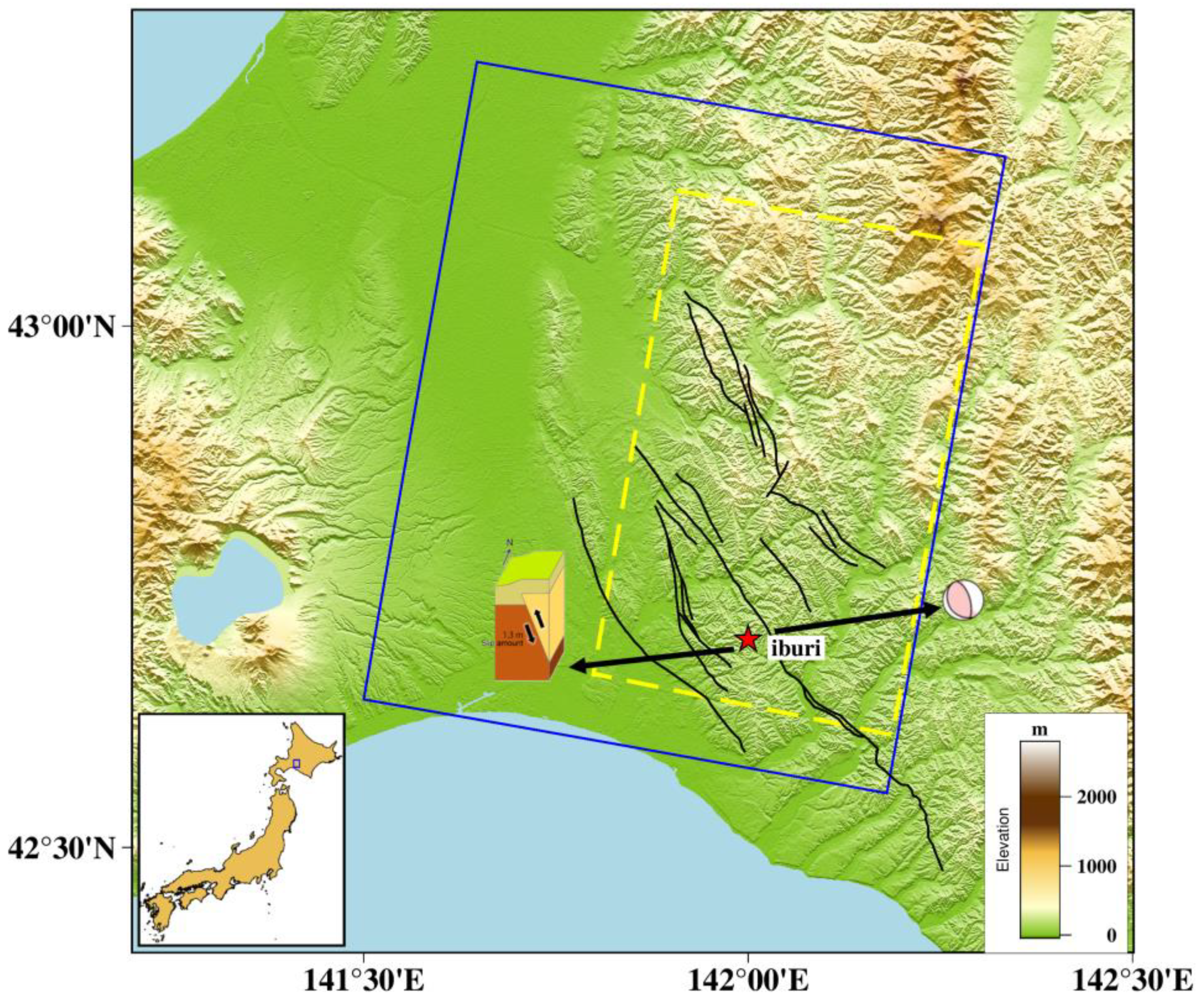

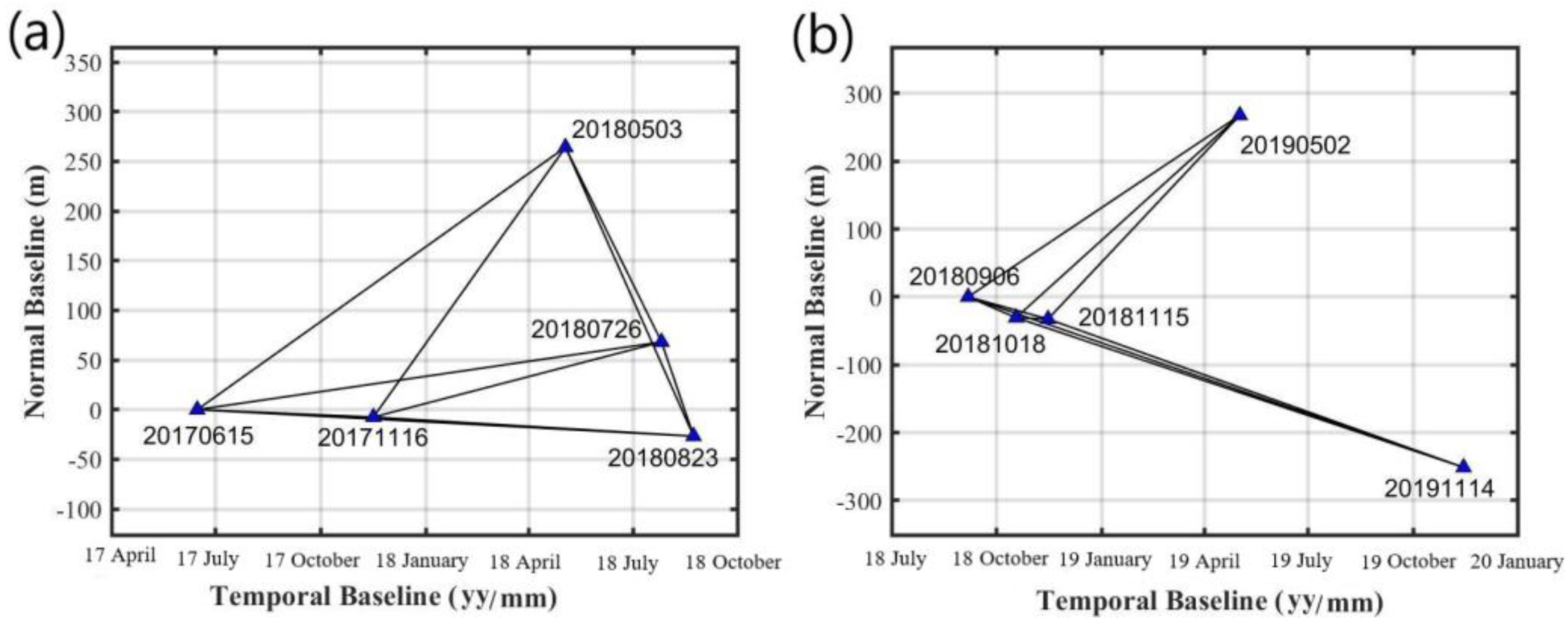
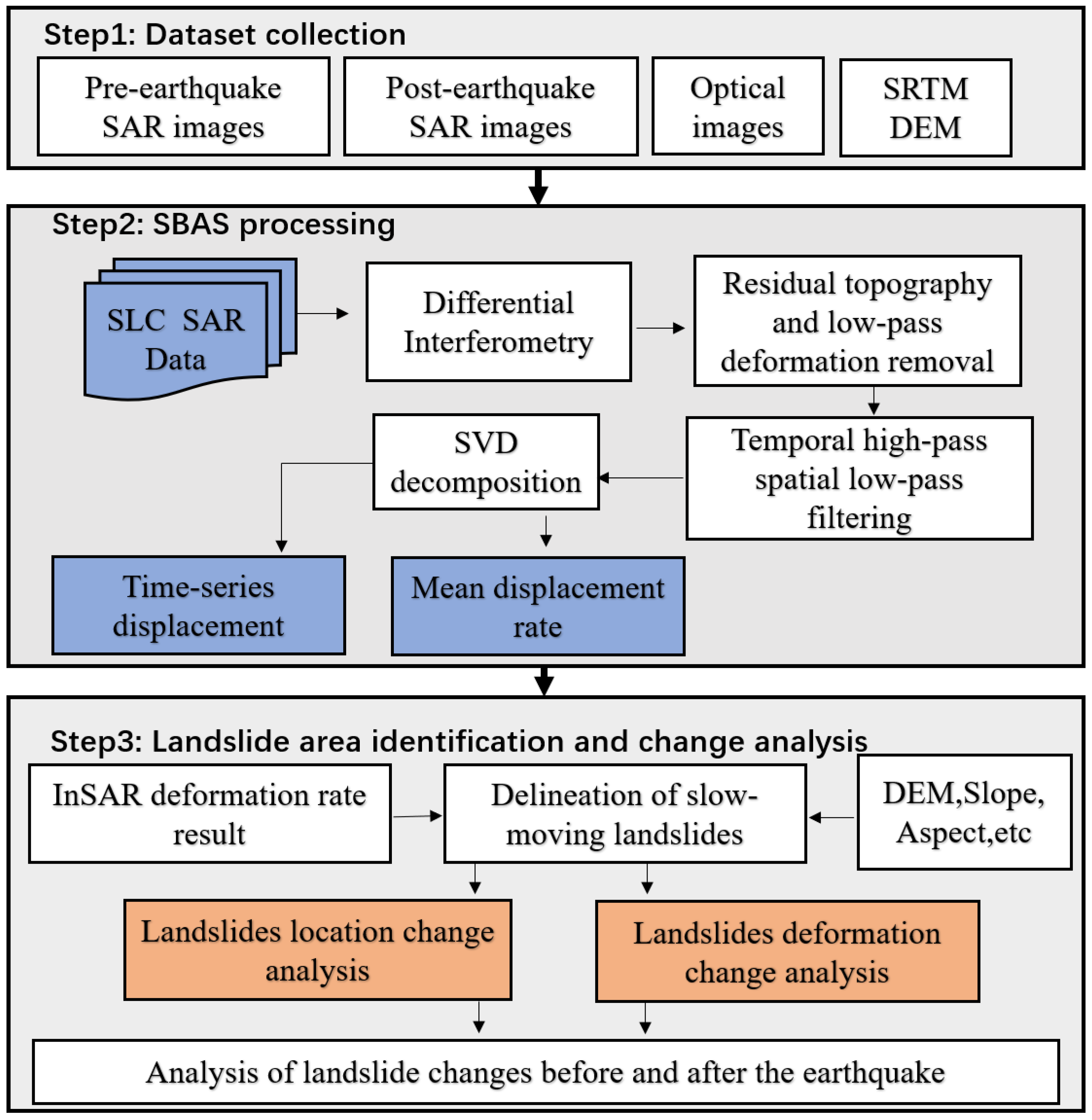
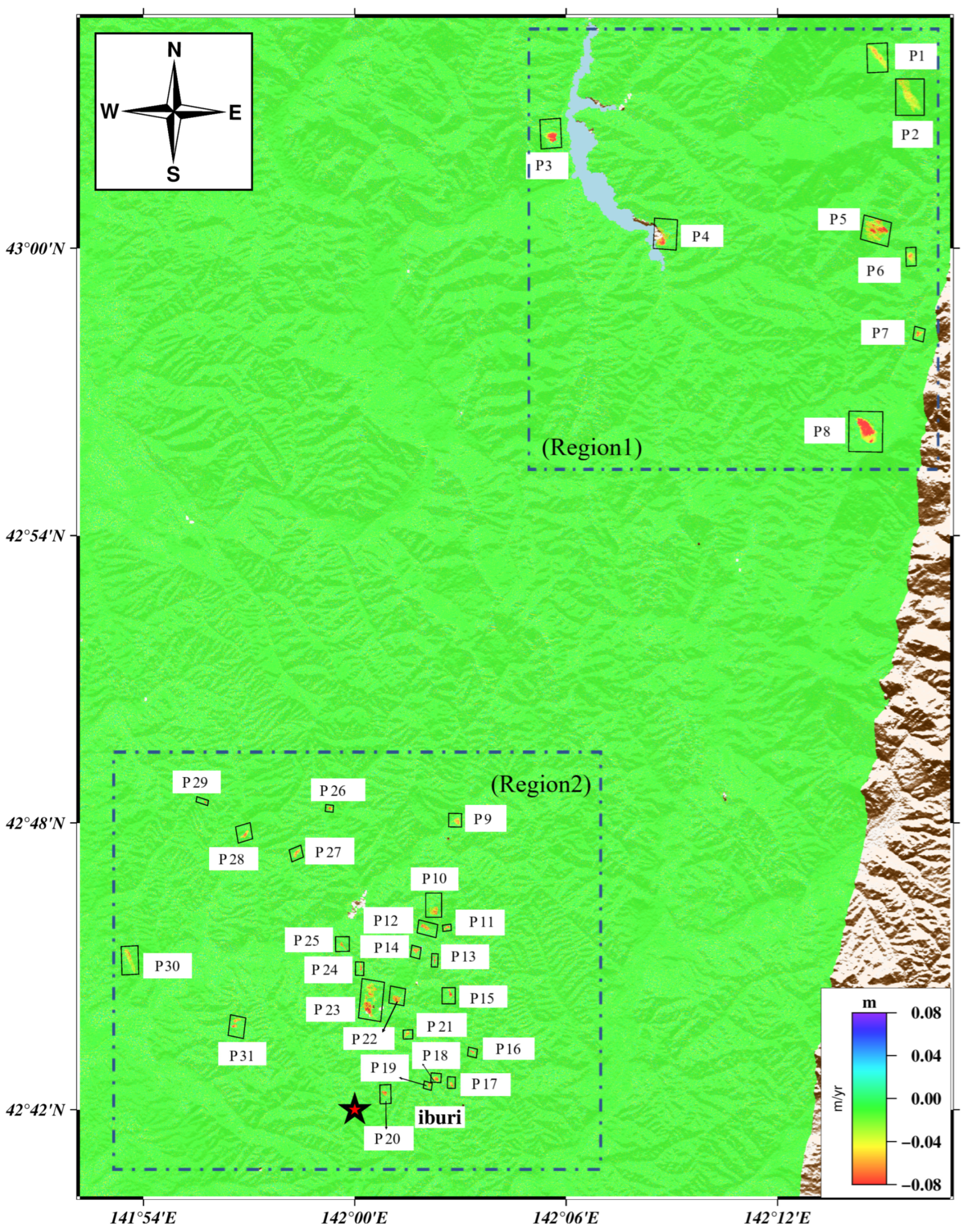
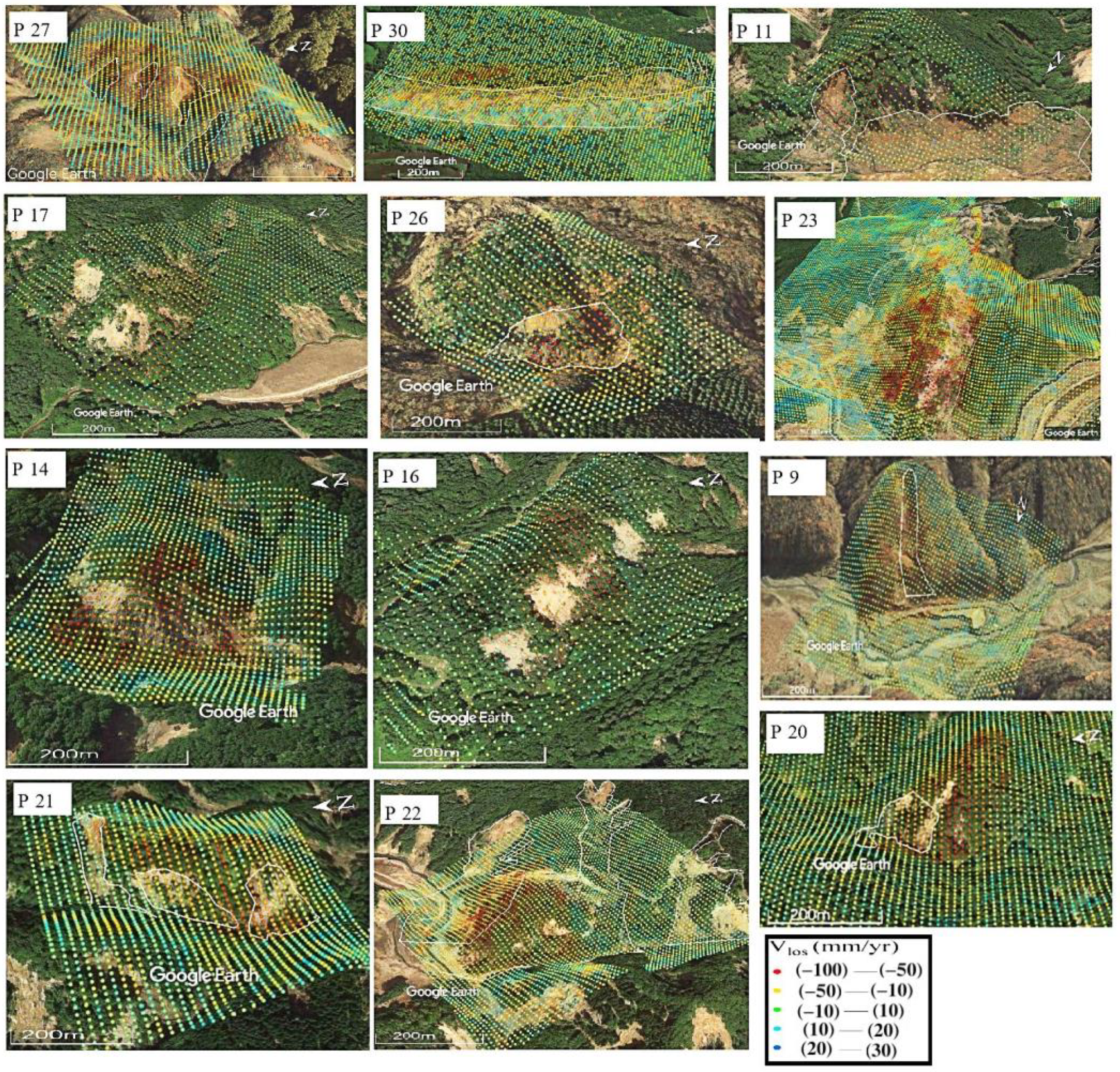
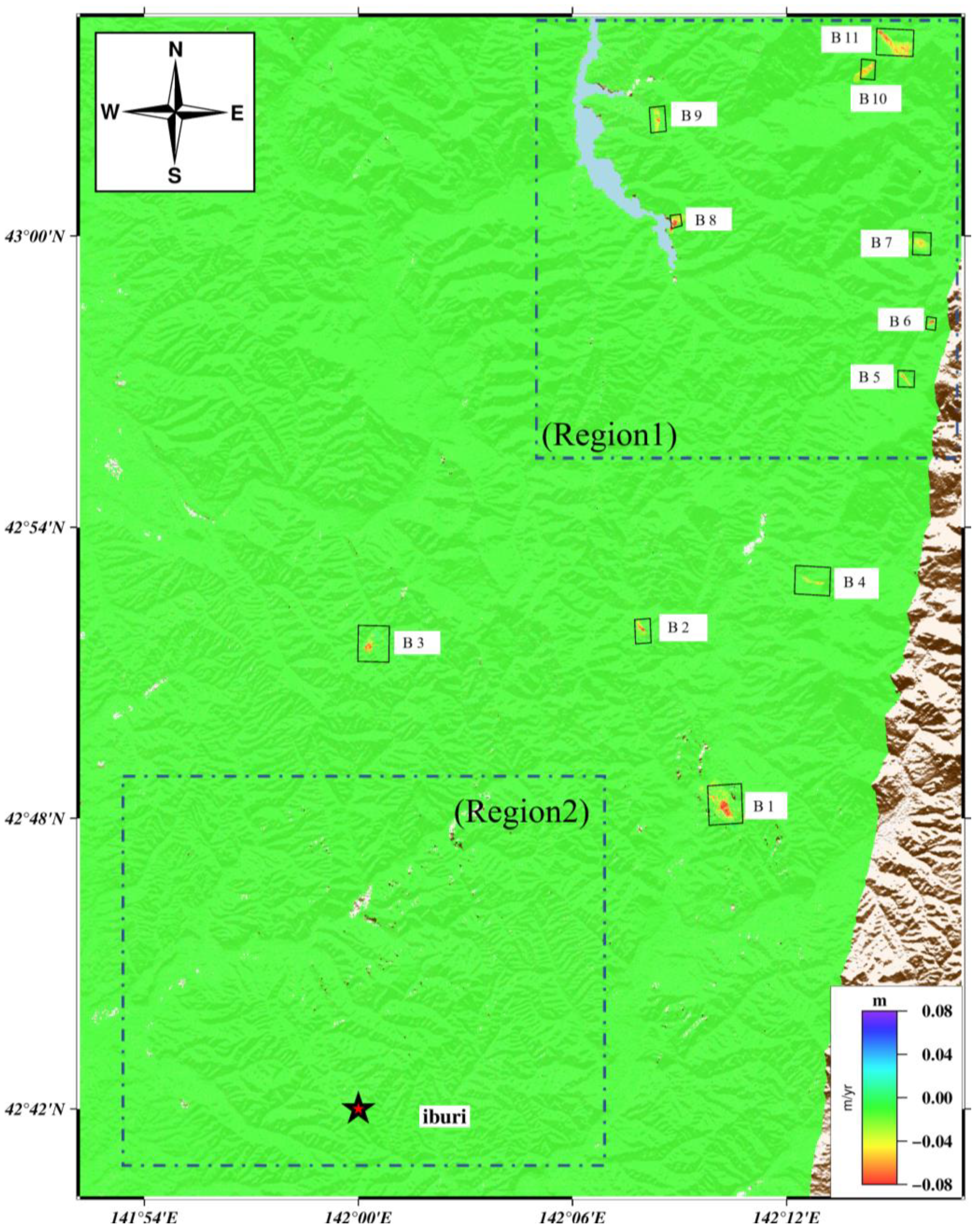

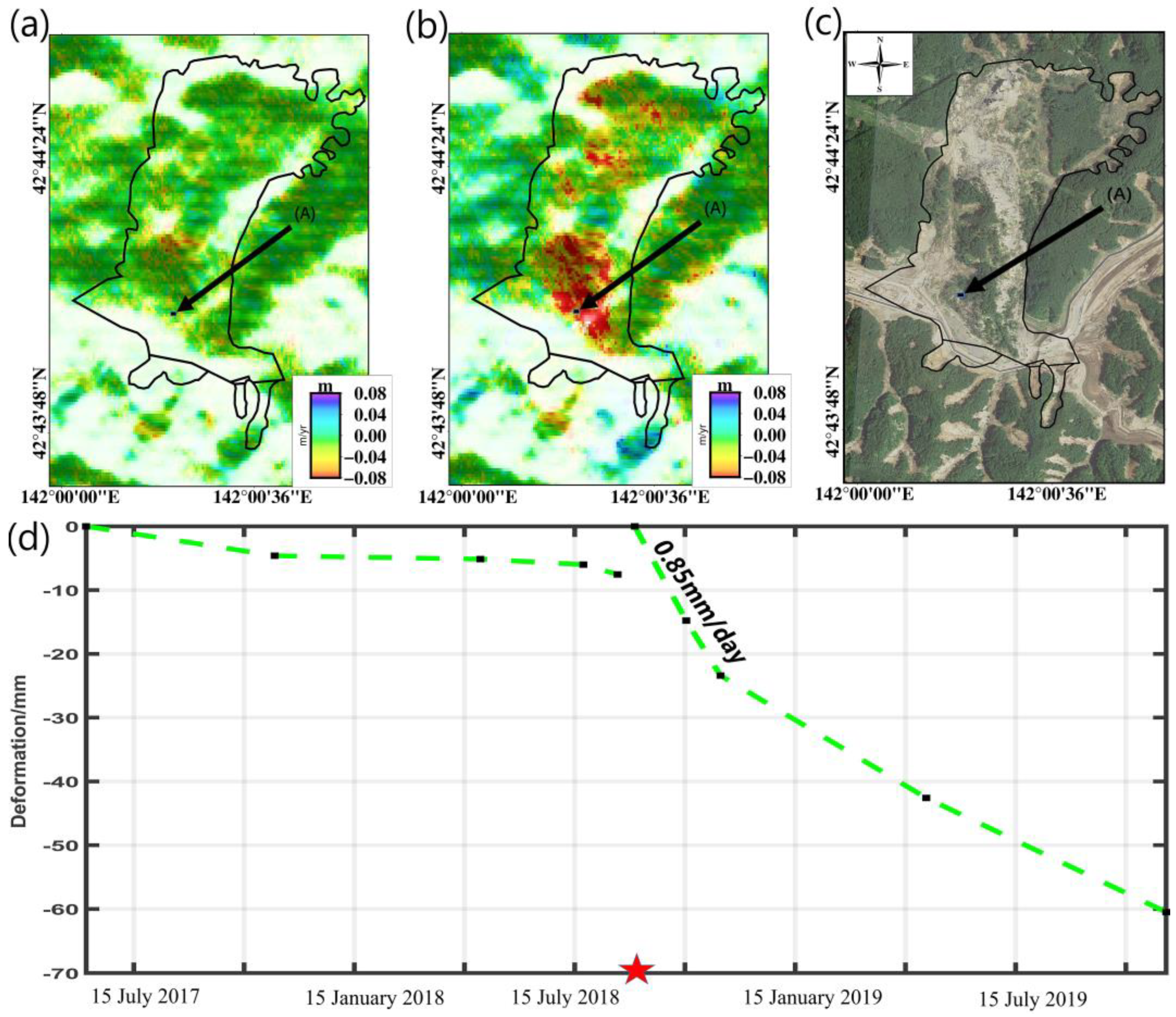
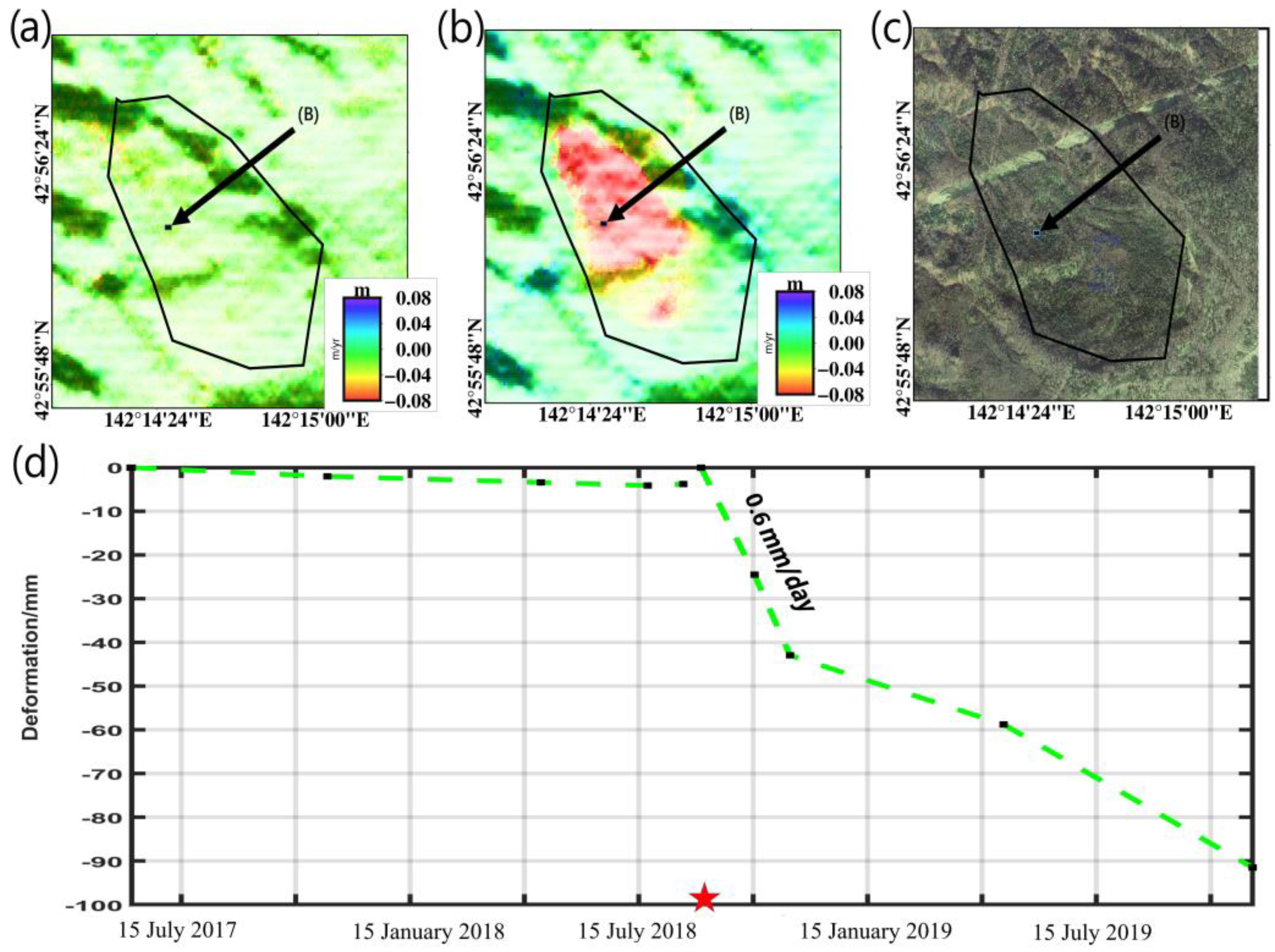
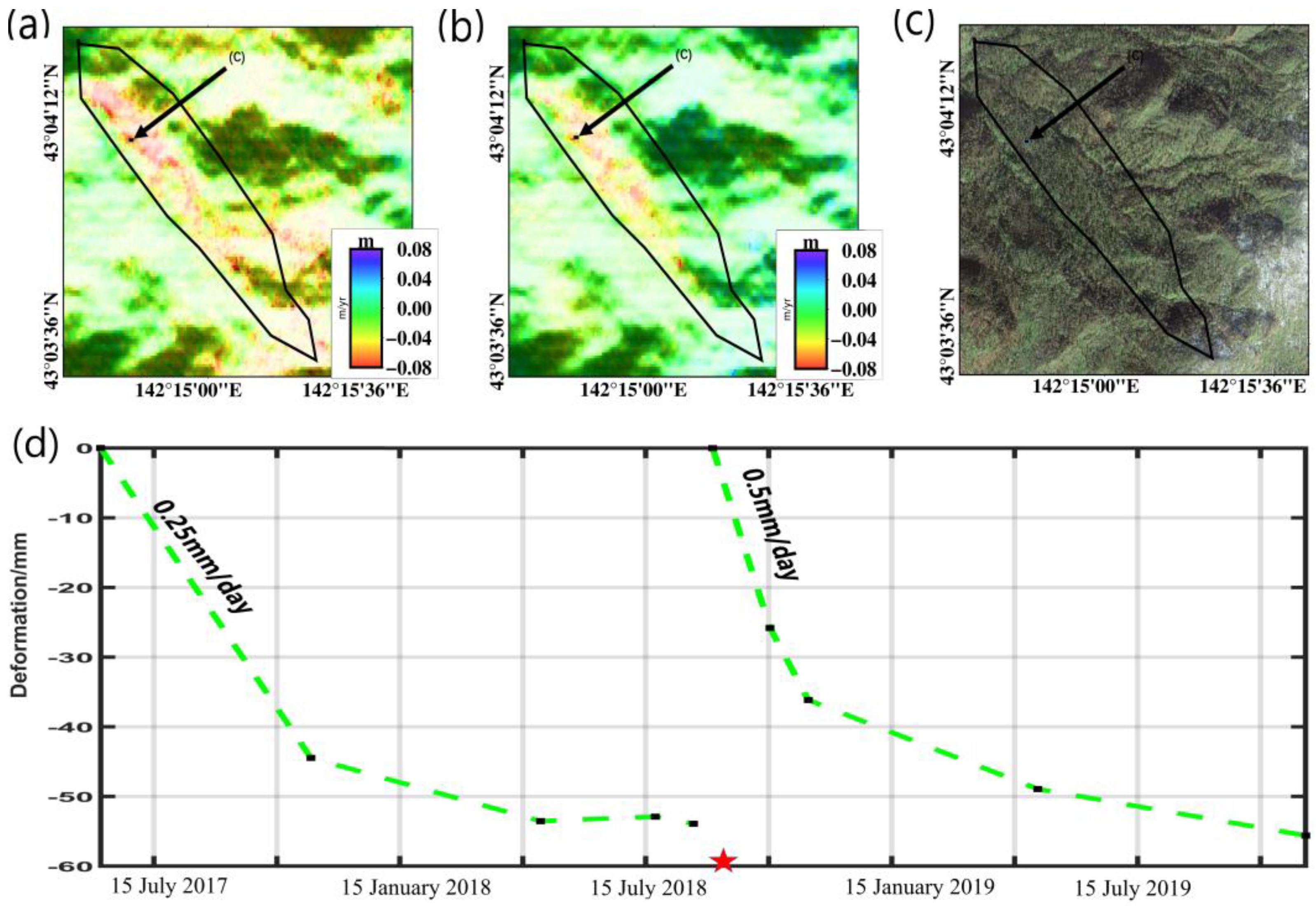

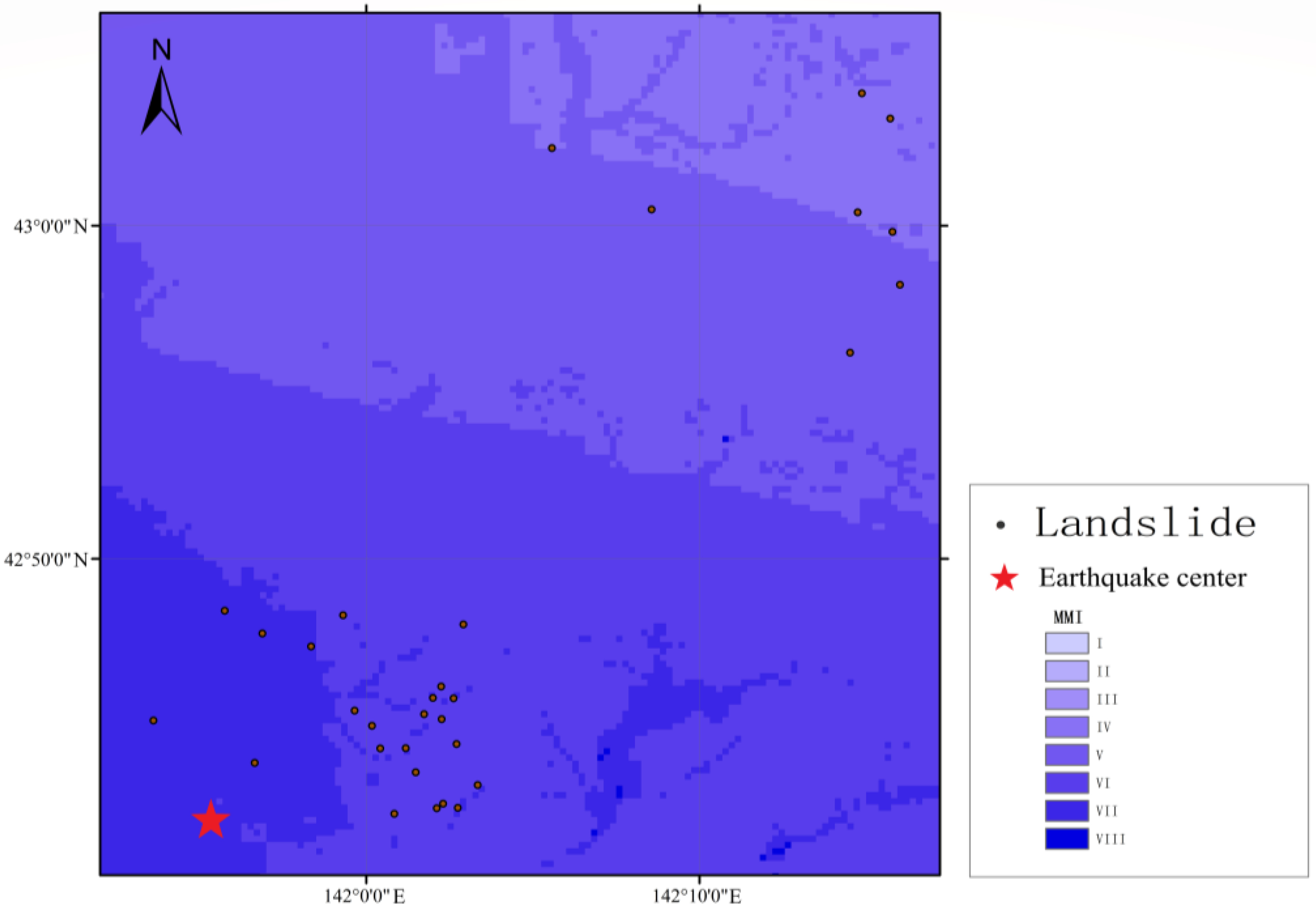

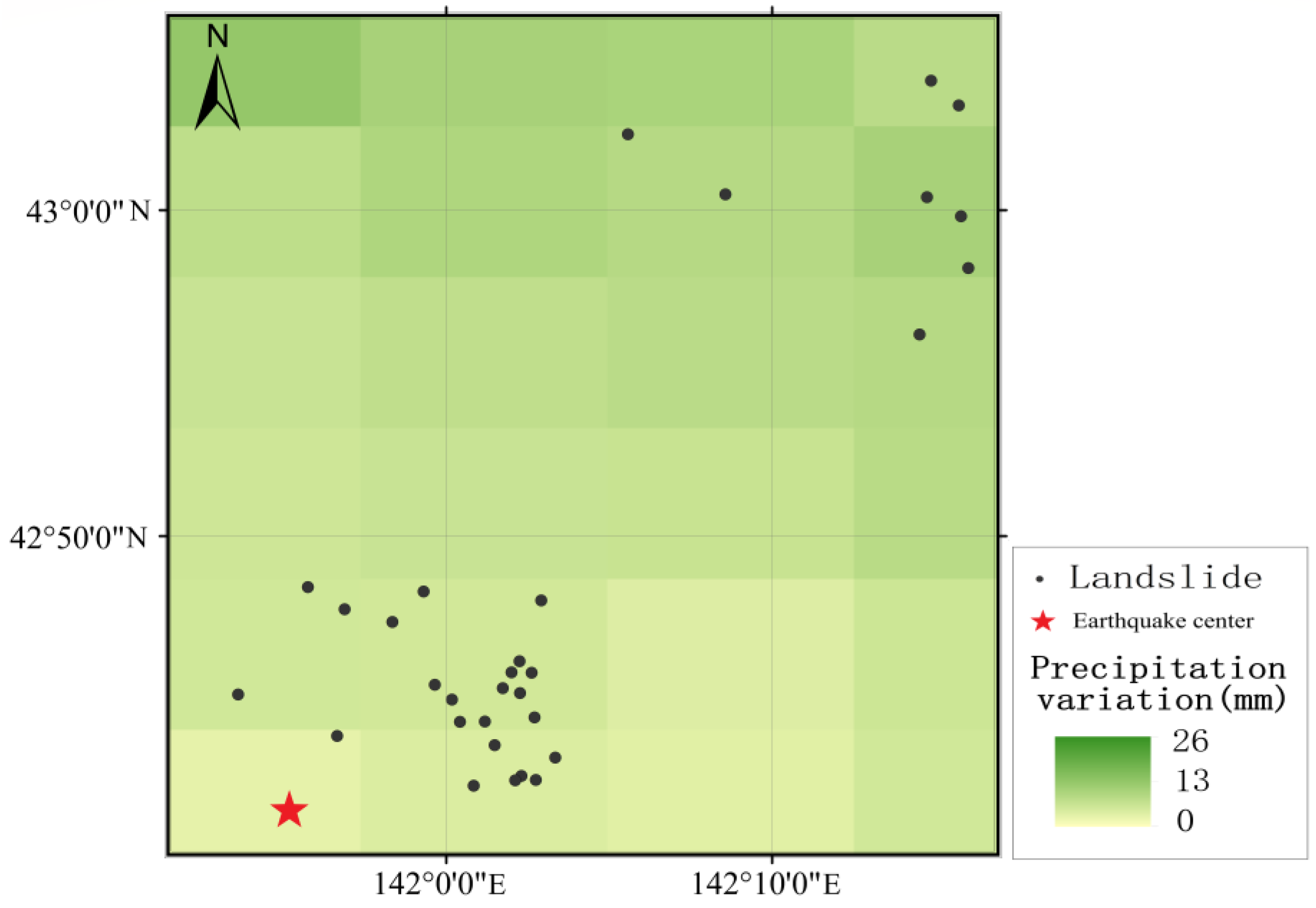

| Data | Orbit | Polarization | Incidence | Spatial Resolution (Range × Azimuth) | Time Interval |
|---|---|---|---|---|---|
| (yyyy/mm/dd) | Angle (°) | (m) | (Days) | ||
| 2017/06/15 | D18 | HH | 36.2 | 3 × 1 | −400 |
| 2017/11/16 | D18 | HH | 36.2 | 3 × 1 | −300 |
| 2018/05/03 | D18 | HH | 36.2 | 3 × 1 | −113 |
| 2018/07/26 | D18 | HH | 36.2 | 3 × 1 | −40 |
| 2018/08/23 | D18 | HH | 36.2 | 3 × 1 | −13 |
| 2018/09/06 1 | D18 | HH | 36.2 | 3 × 1 | 0 |
| 2018/10/18 | D18 | HH | 36.2 | 3 × 1 | 32 |
| 2018/11/15 | D18 | HH | 36.2 | 3 × 1 | 59 |
| 2019/05/02 | D18 | HH | 36.2 | 3 × 1 | 246 |
| 2019/11/14 | D18 | HH | 36.2 | 3 × 1 | 400 |
| Lithology | Lithological Characteristics |
|---|---|
| Kb | Alternating beds of sandstone and mudstone conglomerate and sandstone |
| Fu | Alternating beds of sandstone and mudstone conglomerate and hyaloclastite |
| YZ | Mudstone, sandstone, and conglomerate with tuff and limestone |
| Pn | Siltstone with sandstone and tuff |
| S | Intrusive rocks |
| Ka | Diatomaceous to siliceous mudstone and glauconite sandstone with tuff |
| Mb | Diatomaceous to siltstone with sandstone and conglomerate |
| TK | Mudstone, sandstone, and alternating beds of sandstone and mudstone, with conglomerate and tuff |
| Sa | Andesite to dacite lava and Pyroclastic rocks |
| a | Silt, clay, sand, gravel, and peat |
| s2 | Gravel, sand, and mud, with peat and volcanic ash |
| s11 | Gravel, sand, and mud |
| Data | Severe Subsidence | Light Subsidence | Stable Area |
|---|---|---|---|
| (dd mm yyyy) | (km2) | (km2) | (km2) |
| 15 June 2017 | 0 | 0 | 0 |
| 16 November 2017 | 1.29 | 3.21 | 1920.50 |
| 3 May 2017 | 1.28 | 2.98 | 1920.74 |
| 26 July 2018 | 1.42 | 2.87 | 1920.71 |
| 23 August 2018 | 1.67 | 3.51 | 1919.83 |
| 6 September 2018 1 | 0 | 0 | 0 |
| 18 October 2018 | 2.56 | 5.06 | 1917.38 |
| 15 November 2018 | 2.42 | 4.74 | 1917.84 |
| 2 May 2019 | 1.92 | 3.89 | 1919.19 |
| 14 November 2019 | 1.42 | 3.45 | 1920.13 |
Disclaimer/Publisher’s Note: The statements, opinions and data contained in all publications are solely those of the individual author(s) and contributor(s) and not of MDPI and/or the editor(s). MDPI and/or the editor(s) disclaim responsibility for any injury to people or property resulting from any ideas, methods, instructions or products referred to in the content. |
© 2023 by the authors. Licensee MDPI, Basel, Switzerland. This article is an open access article distributed under the terms and conditions of the Creative Commons Attribution (CC BY) license (https://creativecommons.org/licenses/by/4.0/).
Share and Cite
He, C.; Sun, Q.; Hu, J.; Gui, R. Location and Activity Changes of Slow-Moving Landslides Due to an Earthquake: Perspective from InSAR Observations. Remote Sens. 2023, 15, 1977. https://doi.org/10.3390/rs15081977
He C, Sun Q, Hu J, Gui R. Location and Activity Changes of Slow-Moving Landslides Due to an Earthquake: Perspective from InSAR Observations. Remote Sensing. 2023; 15(8):1977. https://doi.org/10.3390/rs15081977
Chicago/Turabian StyleHe, Caihong, Qian Sun, Jun Hu, and Rong Gui. 2023. "Location and Activity Changes of Slow-Moving Landslides Due to an Earthquake: Perspective from InSAR Observations" Remote Sensing 15, no. 8: 1977. https://doi.org/10.3390/rs15081977
APA StyleHe, C., Sun, Q., Hu, J., & Gui, R. (2023). Location and Activity Changes of Slow-Moving Landslides Due to an Earthquake: Perspective from InSAR Observations. Remote Sensing, 15(8), 1977. https://doi.org/10.3390/rs15081977






